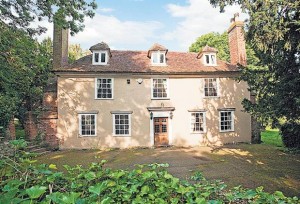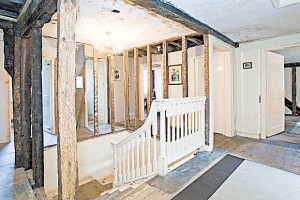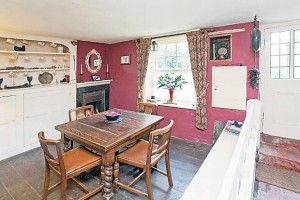
We’ve all seen it on the telly. Couple buys wreck, hires builders, has a few nasty surprises, pulls it round by the last advert break and hey presto house worth a fortune. That’s the fantasy anyway. But is it really as simple as it looks?
First of all you have to find the right property. So how do you decide when is a wreck worth renovating and when should you run, very fast, in the opposite direction?
WHAT TO LOOK FOR?
Old houses can be money pits. If there’s wood chip on all the walls, the chances are that it will all need at least a skim of plaster throughout, although this is just a cosmetic, if messy, problem. Make sure you know how much you are prepared to do yourself in advance. If it’s about redecorating and replacing the kitchen and bathroom then be honest with yourself if that’s all you can manage. If you don’t mind stripping it back to the brick and spending money on windows, wiring and plumbing – stuff that you won’t necessarily see – and living in a rented flat while it’s being done then a wreck might be the right thing for you.
Simon Corringham, director of Faron Sutaria, says: “The advantage of buying a wreck is that you can create a home to your own specifications. But do make sure you really have the time and energy to devote to it as it is all consuming.”
A couple of years ago you wouldn’t get near a wreck as the developers magically seemed to get to them first before the estate agents ever advertised them. But times are tougher now. It’s harder to make a quick buck from turning around a renovation and sticking it back on the market and so there are more wrecks around.

WHEN IS A CRACK SCARY?
A survey is a must – you would be amazed how many people don’t bother with that – but in addition you can get free advice from roofers, timber and damp experts and electricians who will then give you estimates for the work involved, all of which can help you work out the budget, although remember they too have an agenda. An architect can help you with this and can often save you money as you go along so what seems like a large outlay may turn out to be a money saver in the long run.
Check that doors and windows open easily – sticking can be a sign of structural movement. Cracks around bay windows and the corners of doors will need further investigation. Springy floors can mean rotten joists.
Damp can be hard to spot as it may have been painted over but feel the walls to see if they are cold. Mould may not be a disaster if it is high up as it can be a ventilation issue. Lower down the walls might be a problem although a damp proof course can solve that.”
EASY JOBS FOR BIG IMPACT
Moving internal walls around is messy but relatively inexpensive (if it’s not a supporting wall which needs a joist) and can make a huge difference. The most obvious in recent years has been knocking two reception rooms together to make one large one running from front to back of the house. But you might also be able to pinch a bit from a bedroom to turn a small loo into a shower room or put up a stud wall in a large bedroom to create an en suite.

HOW TO FIGURE OUT A BUDGET
Someone once likened moving house to standing under a shower in an Yves Chanel suit while ripping up £50 notes. Imagine how much more you will be chucking about for a renovation. If you don’t already have a builder that you like, then get quotes from up to five others. Times are hard so you can negotiate, but make sure you don’t drive them down so much that they add it all back on again during the job. I was once charged £250 extra for filing doors to fit after a new floor had been laid that was higher than the old one therefore jamming the doors. Repeated protests that it was the builder’s job to factor that obvious problem into the original quote fell on deaf ears.
Go round the house with the builder and then go back round on your own with a very detailed eye and look for things you and he may not have noticed on first inspection. Where are the manholes, is there an extractor fan that needs moving, are the radiators in the right place? Then ask if he has added those details in or will that be more?
Does the quote include sockets, plugs and spotlights? Will the grout for the tiles be supplied and is the cost included in the quote? What about the paint? Go round and round and round again until you feel you have covered every eventuality. Better to have a high quote that shouldn’t have too many nasty surprises than a low one that goes up every week for “variations”. You won’t catch everything in advance but at least that way the contingency fund is for the surprises rather than the essentials.
THE HIDDEN COSTS
You should be able to negotiate a fee with your architect depending on how much you want them to do. If you have no idea how you plan to develop your property then see if they will come for an initial chat and perhaps after that a hourly rate should apply if they need to come back several times to discuss ideas. You should be able to get a set of drawings done that can be submitted to the council for around £1,000 to £1,500. It will then cost around £150 to ask for planning permission and £450 to get the property signed off by building control at the end. If you have to negotiate a party wall agreement that can cost you the fee for your own surveyor and one for your neighbour too.
Don’t forget that it costs money to move boilers and remove and install meters if you are going from flats to a house or vice versa. If you have bought flats that you want to convert back then you will have two sets of council tax and utility bills until the property can be registered as a single dwelling again which, take it from me, can be a bureaucratic nightmare.
THE CONTINGENCY FUND
The most basic advice is that it will take twice as long and cost twice as much as you planned/feared. A rough guide is to allow ten to 15 per cent of the overall budget as you never know what you will find. A friend of mine who is undergoing extensive refurbishment was recently alerted to a cupboard full of pipes leading from her boiler that had completely flummoxed her builders. Written in black marker pen in one corner was the sinister phrase: “Installed by Comedy Plumbers PLC”. She is now halfway through an extensive replumbing project that was not included in the original budget.
You should also try keeping the decoration budget separate from the building one so that you can take from the former if necessary. After all, decorating can be done later. Moving a manhole can’t or underpinning can’t.
DO YOU NEED PERMISSION?
These days you can do quite a lot under the rules of permitted development. So you won’t always need permission and can instead apply for a certificate of lawfulness. Check with your council or on planning portal for exact details. Your architect should also advise you on this.
Be careful if you are buying in a conservation area. The council will wish to be heavily involved and may refuse permission for certain things. In one case, a couple who had bought two Cotswold cottage which they wished to knock together weren’t allowed to remove one of the front doors as it would have spoiled the exterior, according to the council. They had to brick it up on the inside and leave it outside for show.
The lesson is that you must do your research thoroughly and, if, necessary talk to the council about the likelihood of being allowed to go ahead with your plans before committing firmly to the purchase.






For lots of the people registered on our site there is a dream about buying a wreck so this is a really useful reminder of what to be looking out for – to avoid falling into the obvious (and less obvious) traps!
Thank you Bee, I wrote this feature after I had already bought my wreck so it was too late for me but I hope some of you, who are considering doing the same thing that it will be useful. While I was researching it, I also came across a couple who had had to abandon their plans halfway through as they ran out of money so, if nothing else, do consider your finances carefully.
If you’ve read the article and are still convinced you’re ready to take on a renovation challenge, drop me a line. Free initial visit with design and layout ideas, an insight on planning issues and budget guidance.
Nick Groom
NG Property Renovation
07800 677202
Hi Nick, and if anyone comes to you with any interesting ideas then do bring them back to Mad About The House and we can do a follow-up post. After all, if you’re going to post a cheeky advert then the least you can do is bring the results back to us!
Kate,
I have only just seen your reply to my cheeky ad! I read all you articles religiously (honest Guv) and am now feeling like a ticked off school boy!
I’ll have to keep you updated more with mu own projects, that are very often wrecks at the outset.
I have three large projects on the go and a handful of smaller ones. If you are interested in knowing more, then let me know. I have now signed up for notification about your new posts!!
Best wishes,
Nick